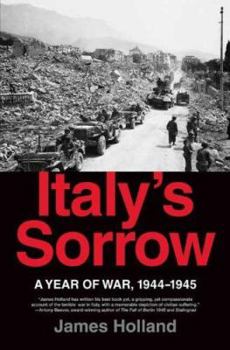Italy's Sorrow: A Year of War, 1944-1945
Select Format
Select Condition 
Book Overview
During the Second World War, the campaign in Italy was the most destructive fought in Europe - a long, bitter and highly attritional conflict that raged up the country's mountainous leg. For frontline... This description may be from another edition of this product.
Format:Hardcover
Language:English
ISBN:0312373961
ISBN13:9780312373962
Release Date:April 2008
Publisher:St. Martin's Press
Length:606 Pages
Weight:2.34 lbs.
Dimensions:2.0" x 6.3" x 9.5"
Customer Reviews
3 ratings
A Stunning and Powerful Work
Published by Thriftbooks.com User , 14 years ago
James Holland's "Italy's Sorrow" is a powerful and illuminating study of the WW II battle for Italy. As a student of history, I find that warfare studies often concentrate so much on the fighting, the movement of army units, the effect of air support and all the other parts of the battle that they overlook the fact that the fighting is taking place somewhere, that people live there, and that those people are often in the way of the warfare. Holland has brought to vivid life the horrendous effect that the fighting up the Italian peninsula had on the towns and the townspeople who had the ill fortune to be in its way. Magnificently researched and with the geography (so much a part of everything in this stretch of warfare) closely described, Holland easily deserves five stars for this great book.
Very good, if not for a few oddities
Published by Thriftbooks.com User , 16 years ago
I've never read anything by James Holland before. Apparently I'm going to have to get used to historians (to say nothing of a President) who are younger than I, which is something of a jarring experience. The current book, however, is a well-researched, well-written account of the course of the campaign in Italy, basically from the last battle of Cassino up through the end of the war. The author spends a lot of time (more than used to be the fashion) discussing the impact of the war on civilians, and he also spends a lot of time discussing the lives of individual soldiers on both sides of the lines. Cassino was one of the most frustrating battles of the war, for the Allies, and the author starts with it, recounting briefly the earlier battles, then recounting in considerable detail the successful attack by the Poles. He also spends a lot of time talking about the famous attack out of the Anzio bridgehead by Mark Clark's Fifth Army, and interestingly defends Clark's decision to turn towards Rome and capture it, as opposed to moving to the fabled Valmontane, where Alexander had ordered him to go. Holland discusses this incident, and the produces a map which shows the main German retreat routes from the Cassino front. Only one of them goes through Valmontane, and the author lets you know this was an alternate, less-important, route. The four further north, out of reach of Clark's forces no matter what he did, were the significant ones. Very interesting thesis. That, in some ways, was the highlight of the book. There's a great deal of information here about various forces and battles, later in the campaign, and much of the information is very well-presented and the judgements are thoughtful. There isn't, however, anything in the way of ground-breaking scholarship for the rest of the book. I did have a few misgivings. At times Holland's understanding of military technology seems a bit weak. One passage includes a discussion of something called an "Ofenrohre". I'm not the world's greatest expert on German militaria, but I know a lot of other amateur experts, and none of us had ever heard the term. It turns out "Ofenrohre" means "stovepipe" in German, and that this was the nickname for the Panzerschrek. *That* we would have understood, but he didn't include the name in the text or anywhere else. At other points he seems to get confused about gun calibers and things of that nature. He also has an odd habit of referencing U.S. Infantry divisions by their divisional nicknames, and occasionally getting them a bit wrong. So for instance, he refers to the 92nd "Buffalo" Division, when of course it should be (if you're going to do it this way) the 92nd "Buffalo Soldier" Division. The term "Buffalo Soldier" traces back to the Indian wars, when said Indians thought a black person's hair looked like buffalo fur. Those few misgivings aside, this is an interesting, well-written book. It includes a considerable amount of information, and the text is well-illustr
a splended book
Published by Thriftbooks.com User , 16 years ago
Rick Atkinson's coverage of the war in Italy through the capture of Rome was an excellent read, but Italy's Sorrow is an essential supplement as well as a great piece of historical writing on its own. The war in Italy was not over when Rome fell, and during the final year much went on that is of considerable interest including two major allied offenses. In addition Holland spends much time covering what the Italians were doing during 1944-45, a history of the Polish divisions before and in Italy, and (as reportedly in his other books) the war as seen by civilians, generals, and grunts. While Atkinson is American and Holland British, it is Holland who makes the best case for Clark and Alexander as able, talented generals. There are many helpful maps, 32 pages of illustrations, and 539 pages of gripping text.






